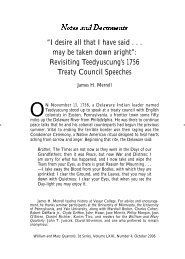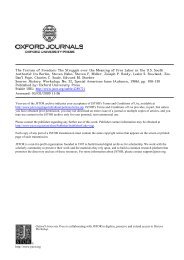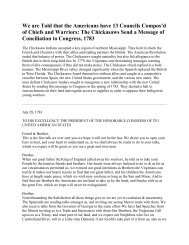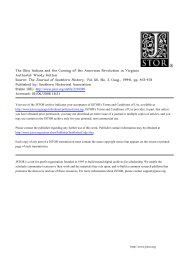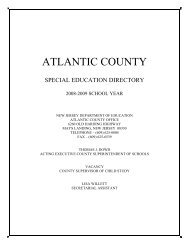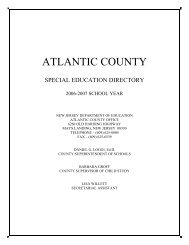A Historical and Regional Overview of Latinas in the United ... - CUNY
A Historical and Regional Overview of Latinas in the United ... - CUNY
A Historical and Regional Overview of Latinas in the United ... - CUNY
Create successful ePaper yourself
Turn your PDF publications into a flip-book with our unique Google optimized e-Paper software.
Introduction: A <strong>Historical</strong> <strong>and</strong> <strong>Regional</strong> <strong>Overview</strong><br />
Puerto Rican community rested largely on specifically<br />
gendered ideologies: like <strong>the</strong> denigrat<strong>in</strong>g views <strong>of</strong><br />
African American women, <strong>the</strong>se views described poor<br />
Puerto Rican women <strong>in</strong> very negative terms. Puerto<br />
Rican <strong>and</strong> o<strong>the</strong>r Lat<strong>in</strong>a women made efforts to better<br />
<strong>the</strong>ir socioeconomic conditions, however, by organiz<strong>in</strong>g<br />
around issues <strong>of</strong> welfare rights, education, <strong>and</strong> employment<br />
discrim<strong>in</strong>ation.<br />
By 1965, when <strong>the</strong> Immigration <strong>and</strong> Naturalization<br />
Act reformed American immigration quotas, Mexican<br />
<strong>and</strong> Puerto Rican migrants to cities like Chicago <strong>and</strong><br />
Detroit were <strong>in</strong>creas<strong>in</strong>gly accompanied by Cuban <strong>and</strong><br />
Central <strong>and</strong> South American immigrants. Aga<strong>in</strong>, while<br />
Lat<strong>in</strong> American men <strong>of</strong>ten immigrated alone as an<br />
economic strategy to provide for <strong>the</strong>ir families back<br />
home, women also immigrated as part <strong>of</strong> household<br />
units. Increas<strong>in</strong>gly <strong>in</strong> <strong>the</strong> 1970s <strong>and</strong> 1980s, however,<br />
women also began immigrat<strong>in</strong>g alone, as men had<br />
done earlier, also seek<strong>in</strong>g to provide economically for<br />
<strong>the</strong>ir families back home.<br />
Cuban immigrants began arriv<strong>in</strong>g <strong>in</strong> larger numbers<br />
after <strong>the</strong> Cuban Revolution <strong>of</strong> 1959. The earliest waves<br />
<strong>of</strong> immigrants <strong>in</strong>cluded mostly pr<strong>of</strong>essionals <strong>and</strong> elites.<br />
By <strong>the</strong> 1980s <strong>the</strong> Cuban immigrant population <strong>in</strong>cluded<br />
more work<strong>in</strong>g-class <strong>and</strong> less educated immigrants as<br />
well. Central <strong>and</strong> South Americans also <strong>in</strong>cluded<br />
middle- <strong>and</strong> upper-class pr<strong>of</strong>essionals, but particularly<br />
for Central Americans, migrants <strong>in</strong>cluded large numbers<br />
<strong>of</strong> political refugees who were flee<strong>in</strong>g civil wars<br />
<strong>and</strong> political unrest <strong>in</strong> war-torn homel<strong>and</strong>s. Mexican<br />
immigrants cont<strong>in</strong>ued arriv<strong>in</strong>g, many <strong>of</strong> whom were<br />
flee<strong>in</strong>g Mexico’s economic devastation dur<strong>in</strong>g <strong>the</strong> late<br />
1970s <strong>and</strong> early 1980s. Lat<strong>in</strong>a women from many <strong>of</strong><br />
<strong>the</strong>se send<strong>in</strong>g countries played crucial roles <strong>in</strong> ma<strong>in</strong>ta<strong>in</strong><strong>in</strong>g<br />
transnational ties <strong>and</strong> social networks between<br />
home <strong>and</strong> <strong>the</strong> U.S. ma<strong>in</strong>l<strong>and</strong>.<br />
By <strong>the</strong> 1970s <strong>Lat<strong>in</strong>as</strong> <strong>in</strong> <strong>the</strong> Midwest, especially <strong>the</strong><br />
second <strong>and</strong> third generations, became <strong>in</strong>creas<strong>in</strong>gly<br />
politicized <strong>and</strong> more vocal about dem<strong>and</strong><strong>in</strong>g services<br />
<strong>and</strong> rights for <strong>the</strong>ir communities. Women became <strong>the</strong><br />
backbone <strong>of</strong> community organiz<strong>in</strong>g <strong>and</strong> grassroots activism<br />
<strong>and</strong> led various struggles for equitable hous<strong>in</strong>g,<br />
education, employment, <strong>and</strong> welfare rights. Maria<br />
Cerda, a Puerto Rican woman, became <strong>the</strong> first Hispanic<br />
to serve on <strong>the</strong> Chicago Board <strong>of</strong> Education<br />
<strong>in</strong> 1969. She advocated assiduously for bil<strong>in</strong>gual education<br />
<strong>and</strong> a school curriculum that valued Lat<strong>in</strong>a/o<br />
children’s cultural backgrounds. Six years later Cerda<br />
became <strong>the</strong> first executive director <strong>of</strong> <strong>the</strong> Lat<strong>in</strong>o Institute,<br />
a research <strong>and</strong> advocacy agency that provided<br />
technical assistance <strong>and</strong> support for local Lat<strong>in</strong>a/o<br />
community-based organizations. In 1973 Mexican <strong>and</strong><br />
Puerto Rican women <strong>in</strong> Chicago founded Mujeres <strong>Lat<strong>in</strong>as</strong><br />
en Acción, a social service <strong>and</strong> advocacy agency<br />
that serves Spanish-speak<strong>in</strong>g women. Mexican moth-<br />
18<br />
q<br />
ers <strong>in</strong> Chicago dur<strong>in</strong>g <strong>the</strong> 1970s also led <strong>the</strong> struggle<br />
aga<strong>in</strong>st <strong>in</strong>equitable, segregated, <strong>and</strong> <strong>in</strong>ferior education<br />
for <strong>the</strong>ir children <strong>in</strong> overcrowded Mexican neighborhood<br />
schools. As small numbers <strong>of</strong> women began<br />
ga<strong>in</strong><strong>in</strong>g access to higher education <strong>and</strong> pr<strong>of</strong>essions,<br />
<strong>Lat<strong>in</strong>as</strong> also became more visible as artists, educators<br />
<strong>and</strong> bus<strong>in</strong>esswomen <strong>and</strong> <strong>in</strong> o<strong>the</strong>r pr<strong>of</strong>essional roles<br />
dur<strong>in</strong>g <strong>the</strong> 1970s <strong>and</strong> 1980s. By <strong>the</strong> end <strong>of</strong> <strong>the</strong> twentieth<br />
century <strong>Lat<strong>in</strong>as</strong> began flex<strong>in</strong>g some political power<br />
as well, runn<strong>in</strong>g for city, county, <strong>and</strong> state political<br />
seats <strong>and</strong> ga<strong>in</strong><strong>in</strong>g political appo<strong>in</strong>tments <strong>in</strong> municipal<br />
government.<br />
Still, <strong>Lat<strong>in</strong>as</strong> <strong>in</strong> <strong>the</strong> Midwest struggle with gender<br />
<strong>and</strong> racial discrim<strong>in</strong>ation <strong>in</strong> education, hous<strong>in</strong>g, <strong>and</strong><br />
employment. Recent immigrants, <strong>in</strong> particular, experience<br />
high rates <strong>of</strong> poverty, low wages, <strong>in</strong>equitable education,<br />
<strong>and</strong> <strong>in</strong>adequate hous<strong>in</strong>g. But U.S.-born <strong>Lat<strong>in</strong>as</strong><br />
also experience high rates <strong>of</strong> unemployment, poverty,<br />
<strong>and</strong> lack <strong>of</strong> educational resources. <strong>Lat<strong>in</strong>as</strong> <strong>in</strong> <strong>the</strong> region<br />
have faced particular challenges over <strong>the</strong><br />
decades. Be<strong>in</strong>g <strong>in</strong> a geographic region that is <strong>of</strong>ten<br />
overlooked by <strong>the</strong> East Coast–West Coast emphasis on<br />
<strong>Lat<strong>in</strong>as</strong>/os, <strong>Lat<strong>in</strong>as</strong> have had to work hard to make<br />
<strong>the</strong>ir communities visible on <strong>the</strong> national level. They<br />
have also encountered significant diversity with<strong>in</strong> <strong>the</strong><br />
Lat<strong>in</strong>a/o community <strong>in</strong> <strong>the</strong> region. Today Lat<strong>in</strong>a immigrants<br />
cont<strong>in</strong>ue to arrive from countries throughout<br />
Lat<strong>in</strong> America—Colombia, Guatemala, Chile, Peru,<br />
Cuba, Mexico, Nicaragua <strong>and</strong> El Salvador. They also<br />
f<strong>in</strong>d, however, long-st<strong>and</strong><strong>in</strong>g communities <strong>of</strong> women<br />
who trace <strong>the</strong>ir roots <strong>in</strong> <strong>the</strong> region back to <strong>the</strong> early<br />
twentieth century.<br />
SOURCES: Fernández, Lilia. 2005. “Lat<strong>in</strong>a/o Migration<br />
<strong>and</strong> Community Formation <strong>in</strong> Postwar Chicago:<br />
Mexicans, Puerto Ricans, Gender, <strong>and</strong> Politics, 1945–<br />
1975.” Ph.D. diss., University <strong>of</strong> California, San Diego.<br />
García, Juan R. 1996. Mexicans <strong>in</strong> <strong>the</strong> Midwest, 1900–<br />
1932. Tucson: University <strong>of</strong> Arizona Press; Padilla,<br />
Elena. 1947. “Puerto Rican Immigrants <strong>in</strong> New York<br />
<strong>and</strong> Chicago: A Study <strong>in</strong> Comparative Assimilation.”<br />
Ph.D. diss., University <strong>of</strong> Chicago; Pérez, G<strong>in</strong>a M. 2004.<br />
The Near Northwest Side Story: Migration, Displacement,<br />
<strong>and</strong> Puerto Rican Families. Berkeley: University <strong>of</strong> California<br />
Press; Vargas, Zaragosa. 1993. Proletarians <strong>of</strong> <strong>the</strong><br />
North: A History <strong>of</strong> Mexican Industrial Workers <strong>in</strong> Detroit<br />
<strong>and</strong> <strong>the</strong> Midwest, 1917–1933. Berkeley: University <strong>of</strong><br />
California Press.<br />
LATINAS IN THE SOUTHEAST<br />
Lilia Fernández<br />
When one th<strong>in</strong>ks <strong>of</strong> traditional areas <strong>of</strong> settlement for<br />
Lat<strong>in</strong>os, one th<strong>in</strong>ks primarily <strong>of</strong> <strong>the</strong> Southwest <strong>and</strong> <strong>the</strong><br />
Nor<strong>the</strong>ast <strong>of</strong> <strong>the</strong> <strong>United</strong> States. However, <strong>the</strong> first Spanish<br />
settlement <strong>in</strong> what is now <strong>the</strong> <strong>United</strong> States was <strong>in</strong>



